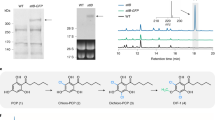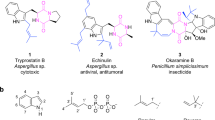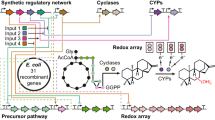Abstract
Isoprenoids are the most numerous and structurally diverse family of natural products. Terpenoids, a class of isoprenoids often isolated from plants, are used as commercial flavor and fragrance compounds and antimalarial or anticancer drugs. Because plant tissue extractions typically yield low terpenoid concentrations, we sought an alternative method to produce high-value terpenoid compounds, such as the antimalarial drug artemisinin, in a microbial host. We engineered the expression of a synthetic amorpha-4,11-diene synthase gene and the mevalonate isoprenoid pathway from Saccharomyces cerevisiae in Escherichia coli. Concentrations of amorphadiene, the sesquiterpene olefin precursor to artemisinin, reached 24 μg caryophyllene equivalent/ml. Because isopentenyl and dimethylallyl pyrophosphates are the universal precursors to all isoprenoids, the strains developed in this study can serve as platform hosts for the production of any terpenoid compound for which a terpene synthase gene is available.
This is a preview of subscription content, access via your institution
Access options
Subscribe to this journal
Receive 12 print issues and online access
$209.00 per year
only $17.42 per issue
Buy this article
- Purchase on Springer Link
- Instant access to full article PDF
Prices may be subject to local taxes which are calculated during checkout






Similar content being viewed by others
References
Cragg, G.M. Paclitaxel (Taxol): a success story with valuable lessons for natural product drug discovery and development. Med. Res. Rev. 18, 315–331 (1998).
Dhingra, V., Rao, K.V. & Narasu, M.L. Current status of artemisinin and its derivatives as antimalarial drugs. Life Sci. 66, 279–300 (2000).
Danishefsky, S.J. et al. Total synthesis of baccatin III and taxol. J. Amer. Chem. Soc. 118, 2843–2859 (1996).
Nicolaou, K.C. et al. Total synthesis of eleutherobin. Angew. Chem. Int. Ed. 36, 2520–2524 (1997).
Avery, M.A., Chong, W.K.M. & Jennings-White, C. Stereoselective total synthesis of (+)-artemisinin, the antimalarial constituent of Artemisia annua L. J. Amer. Chem. Soc. 114, 974–979 (1992).
White, N.J. Artemisinin—Current status. Trans. R. Soc. Trop. Med. Hyg. Suppl. 88, 53–54 (1994).
Ridley, R.G. Medical need, scientific opportunity and the drive for antimalarial drugs. Nature 415, 686–693 (2002).
Haynes, R.K. Artemisinin and derivatives: the future for malaria treatment? Curr. Opin Infect. Dis. 14, 719–726 (2001).
Wallaart, T.E., Pras, N., Beekman, A.C. & Quax, W.J. Seasonal variation of artemisinin and its biosynthetic precursors in plants of Artemisia annua of different geographical origin: proof for the existence of chemotypes. Planta Med. 66, 57–62 (2000).
Jennewein, S. & Croteau, R. Taxol: biosynthesis, molecular genetics, and biotechnological applications. Appl. Microbiol. Biotechnol. 57, 13–19 (2001).
Skeel, R.T. Handbook of Cancer Chemotherapy, edn. 5 (Lippincott Williams & Wilkins, Philadelphia, 1999).
Baekelandt, M. Irofulven (MGI Pharma). Curr. Opin. Investig. Drugs 3, 1517–1526 (2002).
Amato, R.J., Perez, C. & Pagliaro, L. Irofulven, a novel inhibitor of DNA synthesis, in metastatic renal cell cancer. Invest. New Drugs 20, 413–417 (2002).
Boucher, Y. & Doolittle, W.F. The role of lateral gene transfer in the evolution of isoprenoid biosynthesis pathways. Mol. Microbiol. 37, 703–716 (2000).
Rohdich, F. et al. Studies on the nonmevalonate terpene biosynthetic pathway: metabolic role of IspH (LytB) protein. Proc. Natl. Acad. Sci. USA 99, 1158–1163 (2002).
Connolly, D.M. & Winkler, M.E. Genetic and physiological relationships among the miaA gene, 2-methylthio-N6-(Δ2-isopentenyl)adenosine transfer RNA modification, and spontaneous mutagenesis in Escherichia coli K-12. J. Bacteriol. 171, 3233–3246 (1989).
Farmer, W.R. & Liao, J.C. Precursor balancing for metabolic engineering of lycopene production in Escherichia coli. Biotechnol. Prog. 17, 57–61 (2001).
Kajiwara, S., Fraser, P.D., Kondo, K. & Misawa, N. Expression of an exogenous isopentenyl diphosphate isomerase gene enhances isoprenoid biosynthesis in Escherichia coli. Biochem. J. 324, 421–426 (1997).
Kim, S.-W. & Keasling, J.D. Metabolic engineering of the nonmevalonate isopentenyl diphosphate synthesis pathway in Escherichia coli enhances lycopene production. Biotechnol. Bioeng. 72, 408–415 (2001).
Mercke, P., Bengtsson, M., Bouwmeester, H.J., Posthumus, M.A. & Brodelius, P.E. Molecular cloning, expression, and characterization of amorpha-4,11-diene synthase, a key enzyme of artemisinin biosynthesis in Artemisia annua L. Arch. Biochem. Biophys. 381, 173–180 (2000).
Martin, V.J.J., Yoshikuni, Y. & Keasling, J.D. The in vivo synthesis of plant sesquiterpenes by Escherichia coli. Biotechnol. Bioeng. 75, 497–503 (2001).
Kuzuyama, T., Takahashi, S. & Seto, H. Construction and characterization of Escherichia coli disruptants defective in the yaeM gene. Biosci. Biotechnol. Biochem. 63, 776–778 (1999).
Hahn, F.M., Hurlburt, A.P. & Poulter, C.D. Escherichia coli open reading frame 696 is idi, a nonessential gene encoding isopentenyl diphosphate isomerase. J. Bacteriol. 181, 4499–4504 (1999).
Van Geldre, E., Vergauwe, A. & Van den Eeckhout, E. State of the art of the production of the antimalarial compound artemisinin in plants. Plant Mol. Biol. 33, 199–209 (1997).
Bouwmeester, H.J. et al. Amorpha-4,11-diene synthase catalyses the first probable step in artemisinin biosynthesis. Phytochem. 52, 843–854 (1999).
Wallaart, T.E., Bouwmeester, H.J., Hille, J., Poppinga, L. & Maijers, N.C.A. Amorpha-4,11-diene synthase: cloning and functional expression of a key enzyme in the biosynthetic pathway of the novel antimalarial drug artemisinin. Planta 212, 460–465 (2001).
Chang, Y.J., Song, S.H., Park, S.H. & Kim, S.U. Amorpha-4,11-diene synthase of Artemisia annua: cDNA isolation and bacterial expression of a terpene synthase involved in artemisinin biosynthesis. Arch. Biochem. Biophys. 383, 178–184 (2000).
Hale, R.S. & Thompson, G. Codon optimization of the gene encoding a domain from human type 1 neurofibromin protein results in a threefold improvement in expression level in Escherichia coli. Protein Exper. Purif. 12, 185–188 (1998).
Sandmann, G. Combinatorial biosynthesis of carotenoids in a heterologous host: a powerful approach for the biosynthesis of novel structures. Chembiochem. 3, 629–635 (2002).
Huang, Q.L., Roessner, C.A., Croteau, R. & Scott, A.I. Engineering Escherichia coli for the synthesis of taxadiene, a key intermediate in the biosynthesis of taxol. Bioorgan. Med. Chem. 9, 2237–2242 (2001).
Matthews, P.D. & Wurtzel, E.T. Metabolic engineering of carotenoid accumulation in Escherichia coli by modulation of the isoprenoid precursor pool with expression of deoxyxylulose phosphate synthase. Appl. Microbiol. Biotechnol. 53, 396–400 (2000).
Albrecht, M., Misawa, N. & Sandmann, G. Metabolic engineering of the terpenoid biosynthetic pathway of Escherichia coli for production of the carotenoids β-carotene and zeaxanthin. Biotechnol. Lett. 21, 791–795 (1999).
Harker, M. & Bramley, P.M. Expression of prokaryotic 1-deoxy-D-xylulose-5-phosphatases in Escherichia coli increases carotenoid and ubiquinone biosynthesis. FEBS Lett. 448, 115–119 (1999).
Wang, C.-W., Oh, M.-K. & Liao, J.C. Engineered isoprenoid pathway enhances astaxanthin production in Escherichia coli. Biotechnol. Bioeng. 62, 235–241 (1999).
Jung, M., ElSohly, H.N. & McChesney, J.D. Artemisinic acid: a versatile chiral synthon and bioprecursor to natural products. Planta Med. 56, 624 (1990).
Duvold, T., Bravo, J.M., Pale-Grosdemange, C. & Rohmer, M. Biosynthesis of 2-C-methyl-D-erythritol, a putative C-5 intermediate in the mevalonate independent pathway for isoprenoid biosynthesis. Tetrahedron Lett. 38, 4769–4772 (1997).
Campos, N. et al. Escherichia coli engineered to synthesize isopentenyl diphosphate and dimethylallyl diphosphate from mevalonate: a novel system for the genetic analysis of the 2-C-methyl-D-erythritol 4-phosphate pathway for isoprenoid biosynthesis. Biochem. J. 353, 59–67 (2001).
Cunningham, F.X., Sun, Z., Chamovitz, D., Hirschberg, J. & Gantt, E. Molecular structure and enzymatic function of lycopene cyclase from the Cyanobacterium synechococcus sp. strain PCC7942. Plant Cell 6, 1107–1121 (1994).
Polakowski, T., Stahl, U. & Lang, C. Overexpression of a cytosolic hydroxymethylglutaryl-CoA reductase leads to squalene accumulation in yeast. Appl. Microbiol. Biotechnol. 49, 66–71 (1998).
Kovach, M.E. et al. Four new derivatives of the broad-host-range cloning vector pBBR1MCS, carrying different antibiotic-resistance cassettes. Gene 166, 175–176 (1995).
Guzman, L.-M., Belin, D., Carson, M.J. & Beckwith, J. Tight regulation, modulation, and high-level expression by vectors containing the arabinose PBAD promoter. J. Bacteriol. 177, 4121–4130 (1995).
Fujii, H., Koyama, T. & Ogura, K. Efficient enzymatic hydrolysis of polyprenyl pyrophosphates. Biochem. Biophys. Acta 712, 716–718 (1982).
Zhang, D.L. & Poulter, C.D. Analysis and purification of phosphorylated isoprenoids by reversed-phase HPLC. Anal. Biochem. 213, 356–361 (1993).
Acknowledgements
The authors would like to acknowledge Seon-Won Kim, Stephen del Cardayré, Ranjini Chaterjee and David Williams for their contributions and Ahamindra Jain for the synthesis of 2-C-methyl-D-erythritol. This work was supported by research grants from the US National Science Foundation (grant number BES-9911463), University of California BioSTAR (grant number 99-10044), Maxygen and the Office of Naval Research (grant number FDN00014-99-0182). D.J.P. is the recipient of a National Science Foundation graduate fellowship.
Author information
Authors and Affiliations
Corresponding author
Ethics declarations
Competing interests
The authors declare no competing financial interests.
Supplementary information
Rights and permissions
About this article
Cite this article
Martin, V., Pitera, D., Withers, S. et al. Engineering a mevalonate pathway in Escherichia coli for production of terpenoids. Nat Biotechnol 21, 796–802 (2003). https://doi.org/10.1038/nbt833
Received:
Accepted:
Published:
Issue Date:
DOI: https://doi.org/10.1038/nbt833
This article is cited by
-
Efficient production of cembratriene-ol in Escherichia coli via systematic optimization
Microbial Cell Factories (2023)
-
Using a synthetic machinery to improve carbon yield with acetylphosphate as the core
Nature Communications (2023)
-
Engineering the gut microbiome
Nature Reviews Bioengineering (2023)
-
Spontaneously established syntrophic yeast communities improve bioproduction
Nature Chemical Biology (2023)
-
Impact of the Synthetic Scaffold Strategy on the Metabolic Pathway Engineering
Biotechnology and Bioprocess Engineering (2023)



